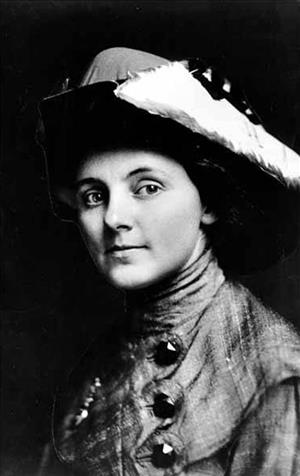On Tuesday February 4, 1919, two days before the Seattle General Strike starts, the Union Record publishes an editorial written by the prominent labor radical Anna Louise Strong (1885-1970). The editorial states the purpose of the citywide strike of all union workers and makes a plea for peace and order. From February 6 to 11, 1919, Seattle's 65,000 union workers go on strike in support of striking shipyard workers.
Fears Are Fanned
Although the editorial paints a humanitarian picture of labor's goals, its open-ended statement that the strike could lead "NO ONE KNOWS WHERE" fans fears of revolution in some of the population. Seattleites -- and indeed Americans -- are unused to general strikes and have been reading of foreign revolts, including the Bolshevik Revolution in Russia. The editorial also fails to state specific objectives for the strike, leaving much up to the imagination.
Four people are mentioned in the editorial: David E. Skinner (1867-1933), head of Skinner and Eddy shipyard; Edgar A. Ames (d. 1944), head of Ames Shipyard; J. F. Duthrie (1863-1932), head of J. F. Duthrie and Company; and Charles Piez, general manager and head of the Emergency Fleet Corporation, a subsidiary of the United States Shipping Board. The first three are members of the Seattle shipyard owners committee that are negotiating with the 30,000 Seattle shipyard workers who struck on January 21, 1919.
Charles Piez headed a corporation, authorized and funded by the U.S. Congress, to build a merchant marine fleet owned by the United States to support the Allies during World War I. One of his functions is to establish workers' wage rates in all privately owned shipyards that receive U.S. contracts to build ships. Seattle metal trades unions had struck in January to protest a regionwide settlement imposed by Piez. The general strike was called to show solidarity with the shipyard workers and to impress employers with the power of labor.
Union Record February 4, 1919 Editorial by Anna Louise Strong
ON THURSDAY AT 10 A.M.
There will be many cheering and there will be some who fear.
Both of these emotions are useful, but not too much of either.
We are undertaking the most tremendous move ever made by LABOR in this country, a move which will lead - NO ONE KNOWS WHERE!
We do not need hysteria.
We need the iron march of labor.LABOR WILL FEED THE PEOPLE.
Twelve great kitchens have been offered, and from them food will be distributed by the provision trades at low cost to all.LABOR WILL CARE FOR THE BABIES AND THE SICK.
The milk-wagons and the laundry drivers are arranging plans for supplying milk to babies, invalids and hospitals, and taking care of the cleaning of linen for hospitals.LABOR WILL PRESERVE ORDER.
The strike committee is arranging for guards, and it is expected that the stopping of the cars will keep people at home.
A few hot-headed enthusiasts have complained that strikers only should be fed, and the general public left to endure severe discomfort. Aside from the inhumanitarian character of such suggestions, let us get this straight -NOT THE WITHDRAWAL OF LABOR POWER, BUT THE POWER OF THE STRIKERS TO MANAGE WILL WIN THIS STRIKE.
What does Mr. Piez of the Shipping Board care about the closing down of Seattle’s shipyards, or even of all the industries of the northwest? Will it not merely strengthen the yards at Hog Island, in which he is more interested?
When the shipyard owners of Seattle were on the point of agreeing with the workers, it was Mr. Piez who wired them that, if they so agreed - HE WOULD NOT LET THEM HAVE STEEL.
Whether this is camouflage we have no means of knowing. But we do know that the great eastern combinations of capitalists COULD AFFORD to offer privately to Mr. Skinner, Mr. Ames and Mr. Duthrie a few millions apiece in eastern shipyard stock.RATHER THAN LET THE WORKERS WIN.
The closing down of Seattle’s industries, as a MERE SHUTDOWN, will not affect these eastern gentlemen much. They could let the whole northwest got to pieces, as far as money alone is concerned.
BUT, the closing down of the capitalistically controlled industries of Seattle, while the WORKERS ORGANIZE to feed the people, to care for the babies and the sick, to preserve order — THIS will move them, for this looks too much like the taking over of POWER by the workers.Labor will not only SHUT DOWN the industries, but Labor will REOPEN, under the management of the appropriate trades, such activities as are needed to preserve public health and public peace. If the strike continues, Labor may feel led to avoid public suffering by reopening more and more activities.
UNDER ITS OWN MANAGEMENT.And that is why we say that we are starting on a road that leads — NO ONE KNOWS WHERE!

